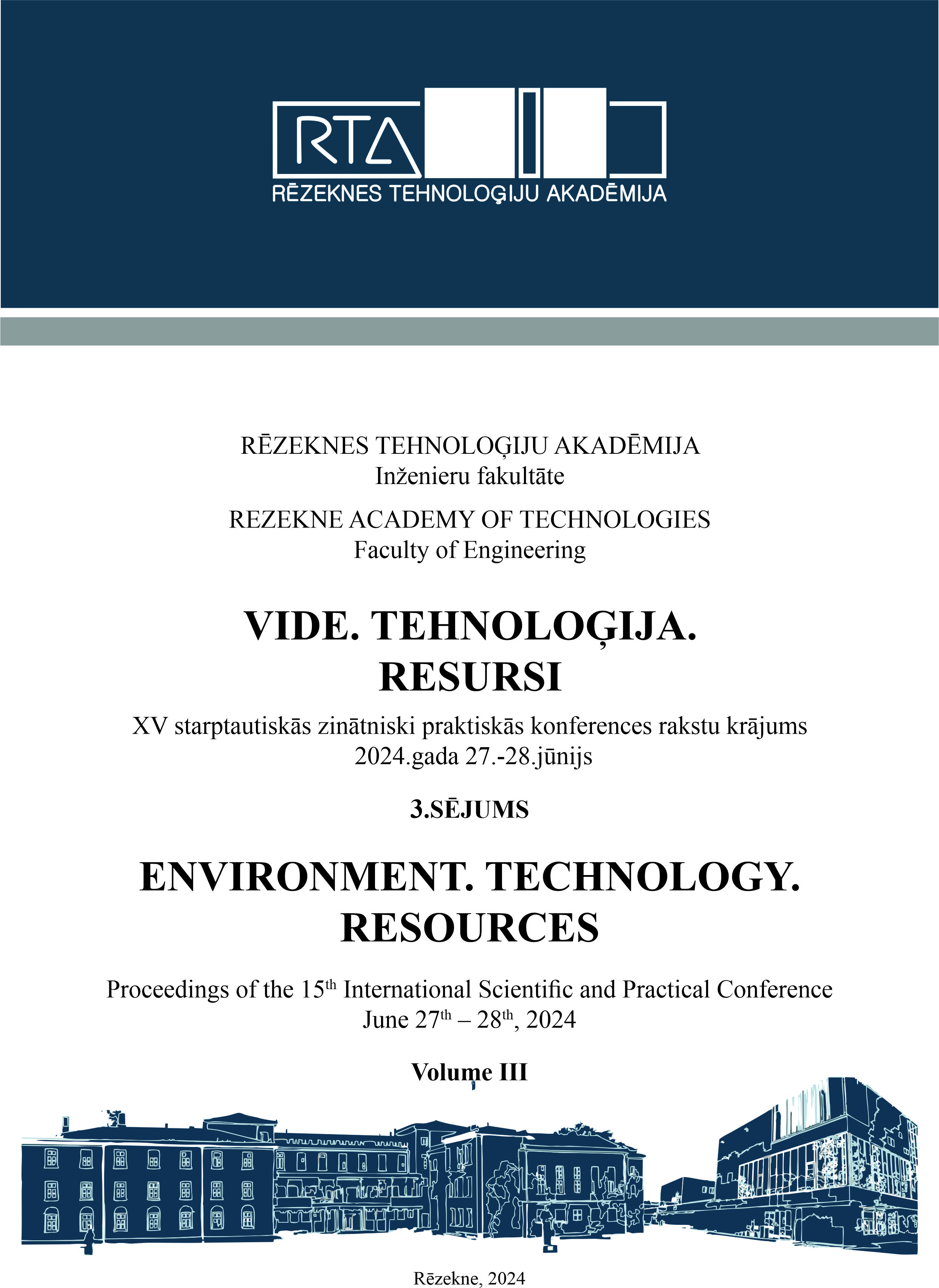HUMIDITY SENSING ELEMENTS BASED ON SILICA-GRAPHENE SURFACE LAYERS
DOI:
https://doi.org/10.17770/etr2024vol3.8153Keywords:
graphene, humidity sensing elements, silica, sol-gel methodAbstract
The paper presents humidity sensing elements based on silica-graphene surface layers, prepared via a sol-gel method. The samples were sintered at temperatures of 400 °C, 600 °C and 800 °C. Tetraethoxysilane was used as a precursor of SiO2 and as a dopant - graphene aggregates of nanoplatelets. A description of the sample preparation procedure is provided. Using a precise impedance analyzer and a calibrator for humidity and temperature, the changes in their resistance R were investigated with variations in relative humidity in the range of 30% to 90% at a temperature of 25 °C and at a frequency of 20 Hz. Morphological observations and map data analyses were carried out by Scanning Electron Microscopy (SEM) and Energy Dispersion Spectroscopy (EDX).
The developed sensor elements have a good sensitivity to the humidity, and the resistance change reaches two orders of magnitude. Additions of graphene improve the sensitivity of the elements.
The characteristics of the sensing elements at different sintering temperatures and different amounts of graphene dopant were modeled using an artificial neural network.
References
Z. Chen, C. Lu, “Humidity Sensors: A Review of Materials and Mechanisms,” Sens. Lett., vol. 3, pp.274–295, 2005.
T. A. Blank, L. P. Eksperiandova, K. N. Belikov, “Recent Trends of Ceramic Humidity Sensors Development: A Review,” Sens. Actuat. B Chem., vol. 228, pp. 416–442, 2016.
Z. Li, H. Zhang, W. Zheng, W. Wang, H. Huang, C. Wang, A.G. MacDiarmid, Y. Wei, “Highly Sensitive and Stable Humidity Nanosensors Based on LiCl Doped TiO2 Electrospun Nanofibers,” J. Am. Chem. Soc., vol. 130, pp. 5036–5037, 2008.
A. Sun, L. Huang, Y. Li, “Study on humidity sensing property based on TiO2 porous film and polystyrene sulfonic sodium,” Sens. Actuat. B Chem., vol.139, pp. 543–547, 2009.
Q. Kuang, C. Lao, Z. L. Wang, Z. Xie, L. Zheng, “High-Sensitivity Humidity Sensor Based on a Single SnO2 Nanowire,” J. Am. Chem. Soc., vol. 129, pp. 6070–6071, 2007.
H. Feng, C. Li, T. Li, F. Diao, T. Xin, B. Liu, Y. Wang, “Three-dimensional hierarchical SnO2 dodecahedral nanocrystals with enhanced humidity sensing properties,” Sens. Actuat. B Chem., vol. 243, pp. 704–714, 2017.
W. Li, J. Liu, C. Ding, G. Bai, J. Xu, Q. Ren, J. Li, “Fabrication of Ordered SnO2 Nanostructures with Enhanced Humidity Sensing Performance,” Sensors, vol. 17, 2392, pp.1-7, 2017.
L. Gu, K. Zheng, Y. Zhou, J. Li, X. Mo, G. R. Patzke, G.Chen, “Humidity sensors based on ZnO/TiO2 core/shell nanorod arrays with enhanced sensitivity,” Sens. Actuat. B Chem., vol.159, pp. 1–7, 2011.
T. Ates, C. Tatar, F. Yakuphanoglu, “Preparation of semiconductor ZnO powders by sol–gel method: Humidity sensors,” Sens. Actuat. A Phys, vol.190, pp.153–160, 2013.
S. Jagtap, K. R. Priolkar, “Evaluation of ZnO nanoparticles and study of ZnO–TiO2 composites for lead free humidity sensors,” Sens. Actuat. B Chem., vol.183, pp.411–418, 2013.
K. Narimani, F. D. Nayeri, M. Kolahdouz, P. Ebrahimi, “Fabrication, modeling and simulation of high sensitivity capacitive humidity sensors based on ZnO nanorods,” Sens. Actuat. B Chem., vol. 224, pp. 338–343, 2016.
M. U. Khan, G. Hassan, M. Awais, J. Bae. “All printed full range humidity sensor based on Fe2O3,” Sensors and Actuators A, vol. 311, 112072, 2020.
H. Yu, S. Gaoa, X. Cheng, P. Wang, X. Zhang, Y. Xu, H. Zhao, L. Huo. “Morphology controllable Fe2O3 nanostructures derived from Fe-based metal-organic frameworks for enhanced humidity sensing performances,” Sensors and Actuators B, vol.297, 126744, 2019.
Z. P. Nenova, S. V. Kozhukharov, T. G. Nenov, N. D. Nedev, M.S.Machkova. “Characterization of Humidity Sensors with Ce-modified Silica Films Prepared via Sol-gel Method,” Bulgarian Chemical Communications, vol.45, Special Edition A, pp.11–16, 2013.
Z. Nenova, T. Nenov, S. Kozhukharov, N. Nedev. “Humidity sensing elements based on Si- Bi-O surface layers prepared via a sol-gel method,” IEEE Sensors Journal, vol. 18, no. 17, pp. 6946-6953, 2018.
S. Kozhukharov, Z. Nenova, T. Nenov, N. Nedev, M. Machkova, “Humidity sensing elements based on cerium doped titania-silica thin films prepared via a sol–gel method,” Sensors and Actuators B Chem. vol. 210, pp. 676–684, 2015.
Z. Nenova, S. Kozhukharov, T. Nenov, N. Nedev, M. Machkova. “Combined influence of titania and silica precursors on the properties of thin film humidity sensing elements prepared via a sol-gel method,” Sensors and Actuators B, vol. 224, pp.143-150, 2016.
Z. Nenova, N. Nedev, S. Kozhukharov, T. Nenov, Humidity Sensors Based on Doped Titania-Silica Surface Layers, 20th International Symposium on Electrical Apparatus and Technologies (SIELA), June 3-6, 2018, Bourgas, Bulgaria 2018, pp. 1-4, IEEE Xplore (SCOPUS), doi: 10.1109/SIELA.2018.8447168.
M. Handayani, N. Nafi’ah, A. Nugroho, A. Rasyida, A. B. Prasetyo, E. Febriana, E. Sulistiyono, F. Firdiyono. “The Development of Graphene/Silica Hybrid Composites: A Review for Their Applications and Challenges,” Crystals, vol. 11, 1337, 2021.
I. K. Rind, A. Sarı, M. Tuzen, M. F, Lanjwani, T. A. Saleh. “Synthesis of graphene/silica composites and its removal efficiency of methylene blue dye from water,” Inorganic Chemistry Communications , vol. 158, 111507, 2023.
A. Abdelkhalek, M. A. El Latif, H. Ibrahim, H. Hamad, M. Showman. “Controlled synthesis of graphene oxide/silica hybrid nanocomposites for removal of aromatic pollutants in water,” Scientific Reports, vol. 12, 7060, 2022.
Downloads
Published
Issue
Section
License
Copyright (c) 2024 Nedyu Nedev, Zvezditza Nenova, Stephan Kozhukharov, Stefan Ivanov, Toshko Nenov

This work is licensed under a Creative Commons Attribution 4.0 International License.



